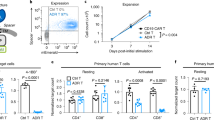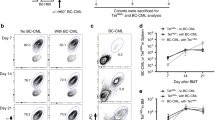Abstract
Adoptive transfer of T cells reactive to minor histocompatibility antigens has the unmatched ability to eradicate malignant hematopoietic cells. Unfortunately, its use is hampered by the associated graft-versus-host disease. The critical issue of a possible dissociation of the antileukemic effect and graft-versus-host disease by targeting specific minor histocompatibility antigens remains unresolved because of the unknown nature and number of minor histocompatibility antigens necessary or sufficient to elicit anti-leukemic activity and graft-versus-host disease. We found that injection of T lymphocytes primed against a single major histocompatibility complex class I-restricted immunodominant minor histocompatibility antigen (B6dom1) caused no graft-versus-host disease but produced a curative anti-leukemic response. Avoidance of graft-versus-host disease required that no other host-reactive T cells be co-injected with T cells primed with B6dom1. Here we show that effective and non-toxic immunotherapy of hematologic malignancies can be achieved by targeting a single immunodominant minor histocompatibility antigen.
This is a preview of subscription content, access via your institution
Access options
Subscribe to this journal
Receive 12 print issues and online access
$209.00 per year
only $17.42 per issue
Buy this article
- Purchase on Springer Link
- Instant access to full article PDF
Prices may be subject to local taxes which are calculated during checkout




Similar content being viewed by others
References
Rosenberg, S.A. A new era for cancer immunotherapy based on the genes that encode cancer antigens. Immunity 10, 281–287 (1999).
Van den Eynde, B.J. & van der Bruggen, P. T cell defined tumor antigens. Curr. Opin. Immunol. 9, 684–693 (1997).
Staveley-O'Carroll, K. et al. Induction of antigen-specific T cell anergy: An early event in the course of tumor progression. Proc. Natl. Acad. Sci. USA 95, 1178–1183 (1998).
Lee, P.P. et al. Characterization of circulating T cells specific for tumor-associated antigens in melanoma patients. Nature Med. 5, 677–685 (1999).
Perreault, C., Roy, D.C. & Fortin, C. Immunodominant minor histocompatibility antigens: The major ones. Immunol. Today 19, 69–74 (1998).
Horowitz, M.M. et al. Graft-versus-leukemia reactions after bone marrow transplantation. Blood 75, 555–562 (1990).
Kolb, H.J. et al. Graft-versus-leukemia effect of donor lymphocyte transfusions in marrow grafted patients. European Group for Blood and Marrow Transplantation Working Party Chronic Leukemia. Blood 86, 2041–2050 (1995).
Gale, R.P. et al. Identical-twin bone marrow transplants for leukemia. Ann. Intern. Med. 120, 646–652 (1994).
Barrett, A.J. et al. Effect of nucleated marrow cell dose on relapse and survival in identical twin bone marrow transplants for leukemia. Blood 95, 3323–3327 (2000).
Collins, R.H.J. et al. Donor leukocyte infusions in 140 patients with relapsed malignancy after allogeneic bone marrow transplantation. J. Clin. Oncol. 15, 433–444 (1997).
Drobyski, W.R. et al. T-cell depletion plus salvage immunotherapy with donor leukocyte infusions as a strategy to treat chronic-phase chronic myelogenous leukemia patients undergoing HLA-identical sibling marrow transplantation. Blood 94, 434–441 (1999).
Goulmy, E. Human minor histocompatibility antigens: new concepts for marrow transplantation and adoptive immunotherapy. Immunol. Rev. 157, 125–140 (1997).
Perreault, C., Jutras, J., Roy, D.C., Filep, J.G. & Brochu, S. Identification of an immunodominant mouse minor histocompatibility antigen (MiHA). T cell response to a single dominant MiHA causes graft-versus-host disease. J. Clin. Invest. 98, 622–628 (1996).
Pion, S., Christianson, G.J., Fontaine, P., Roopenian, D.C. & Perreault, C. Shaping the repertoire of cytotoxic T-lymphocyte responses: explanation for the immunodominance effect whereby cytotoxic T lymphocytes specific for immunodominant antigens prevent recognition of nondominant antigens. Blood 93, 952–962 (1999).
Eden, P.A. et al. Biochemical and immunogenetic analysis of an immunodominant peptide (B6dom1) encoded by the classical H7 minor histocompatibility locus. J. Immunol. 162, 4502–4510 (1999).
Pion, S., Fontaine, P., Baron, C., Gyger, M. & Perreault, C. Immunodominant minor histocompatibility antigens expressed by mouse leukemic cells can serve as effective targets for T cell immunotherapy. J. Clin. Invest. 95, 1561–1568 (1995).
Johnston, J.V. et al. B7-CD28 costimulation unveils the hierarchy of tumor epitopes recognized by major histocompatibility complex class I-restricted CD8+ cytolytic T lymphocytes. J. Exp. Med. 183, 791–800 (1996).
Roderick, T.H. & Guidi, J.N. Genetic variants and strains of the laboratory mouse. (eds. Lyon, M.F. & Searle, A.G.) 663–772 (Oxford University Press, Oxford, 1989).
Fontaine, P., Langlais, J. & Perreault, C. Evaluation of in vitro cytotoxic T lymphocyte assays as a predictive test for the occurrence of graft vs host disease. Immunogenetics 34, 222–226 (1991).
Pion, S. et al. On the mechanisms of immunodominance in cytotoxic T lymphocyte responses to minor histocompatibility antigens. Eur. J. Immunol. 27, 421–430 (1997).
Ciubotariu, R. et al. Persistent allopeptide reactivity and epitope spreading in chronic rejection of organ allografts. J. Clin. Invest. 101, 398–405 (1998).
Korngold, R. & Sprent, J. Lethal GVHD across minor histocompatibility barriers: nature of the effector cells and role of the H-2 complex. Immunol. Rev. 71, 5–29 (1983).
Blouin, A., Bolender, R.P. & Weibel, E.R. Distribution of organelles and membranes between hepatocytes and nonhepatocytes in the rat liver parenchyma. A stereological study. J. Cell Biol. 72, 441–455 (1977).
Goulmy, E. et al. Mismatches of minor histocompatibility antigens between HLA-identical donors and recipients and the development of graft-versus-host disease after bone marrow transplantation. N. Engl. J. Med. 334, 281–285 (1996).
Goulmy, E. Human minor histocompatibility antigens. Curr. Opin. Immunol. 8, 75–81 (1996).
Griem, P. et al. Uneven tissue distribution of minor histocompatibility proteins versus peptides is caused by MHC expression. Cell 65, 633–640 (1991).
Daar, A.S., Fuggle, S.V., Fabre, J.W., Ting, A. & Morris, P.J. The detailed distribution of HLA-A, B, C antigens in normal human organs. Transplantation 38, 287–292 (1984).
Loveland, B. & Simpson, E. The non-MHC transplantation antigens: neither weak nor minor. Immunol. Today 7, 223–229 (1986).
Korngold, R., Leighton, C., Mobraaten, L.E. & Berger, M.A. Inter-strain graft-vs.-host disease T-cell responses to immunodominant minor histocompatibility antigens. Biol. Blood Marrow Transplant. 3, 57–64 (1997).
Mutis, T. et al. Feasibility of immunotherapy of relapsed leukemia with ex vivo- generated cytotoxic T lymphocytes specific for hematopoietic system- restricted minor histocompatibility antigens. Blood 93, 2336–2341 (1999).
Franco, A. et al. Epitope affinity for MHC class I determines helper requirement for CTL priming. Nature Immunol. 1, 145–150 (2000).
Gallimore, A. et al. Induction and exhaustion of lymphocytic choriomeningitis virus-specific cytotoxic T lymphocytes visualized using soluble tetrameric major histocompatibility complex class I-peptide complexes. J. Exp. Med. 187, 1383–1393 (1998).
Brochu, S., Rioux-Massé, B., Roy, J., Roy, D.C. & Perreault, C. Massive activation-induced cell death of alloreactive T cells with apoptosis of bystander postthymic T cells prevents immune reconstitution in mice with graft-versus-host disease. Blood 94, 390–400 (1999).
Ku, C.C., Murakami, M., Sakamoto, A., Kappler, J. & Marrack, P. Control of homeostasis of CD8+ memory T cells by opposing cytokines. Science 288, 675–678 (2000).
Dulude, G., Roy, D.C. & Perreault, C. The effect of graft-versus-host disease on T cell production and homeostasis. J. Exp. Med. 189, 1329–1342 (1999).
Cheever, M.A. & Chen, W. Therapy with cultured T cells: principles revisited. Immunol. Rev. 157, 177–194 (1997).
Altman, J.D. et al. Phenotypic analysis of antigen-specific T lymphocytes. Science 274, 94–96 (1996).
Crawford, F., Kozono, H., White, J., Marrack, P. & Kappler, J. Detection of antigen-specific T cells with multivalent soluble class II MHC covalent peptide complexes. Immunity 8, 675–682 (1998).
Acknowledgements
We thank J.D. Altman for advice on the preparation of H2Db-peptide tetramers; C. Fortin for help with statistical analyses; P.M. Huet for advice on liver cell populations; P. Eden for thoughtful review of the manuscript; Compatigene Inc. for sharing their cell culture and HPLC facilities; the CANVAC Tetramer Core Facility for a gift of plasmid clones; and J.A. Kashul for editorial assistance. Grant 011189 from the National Cancer Institute of Canada supported this work.
Author information
Authors and Affiliations
Corresponding author
Rights and permissions
About this article
Cite this article
Fontaine, P., Roy-Proulx, G., Knafo, L. et al. Adoptive transfer of minor histocompatibility antigen-specific T lymphocytes eradicates leukemia cells without causing graft-versus-host disease. Nat Med 7, 789–794 (2001). https://doi.org/10.1038/89907
Received:
Accepted:
Issue Date:
DOI: https://doi.org/10.1038/89907
This article is cited by
-
Alloantigen expression on malignant cells and healthy host tissue influences graft-versus-tumor reactions after allogeneic hematopoietic stem cell transplantation
Bone Marrow Transplantation (2018)
-
Proteogenomic-based discovery of minor histocompatibility antigens with suitable features for immunotherapy of hematologic cancers
Leukemia (2016)
-
Impact of genomic polymorphisms on the repertoire of human MHC class I-associated peptides
Nature Communications (2014)
-
Exploiting T cells specific for human minor histocompatibility antigens for therapy of leukemia
Immunology & Cell Biology (2011)
-
New perspectives on the biology of acute GVHD
Bone Marrow Transplantation (2010)



